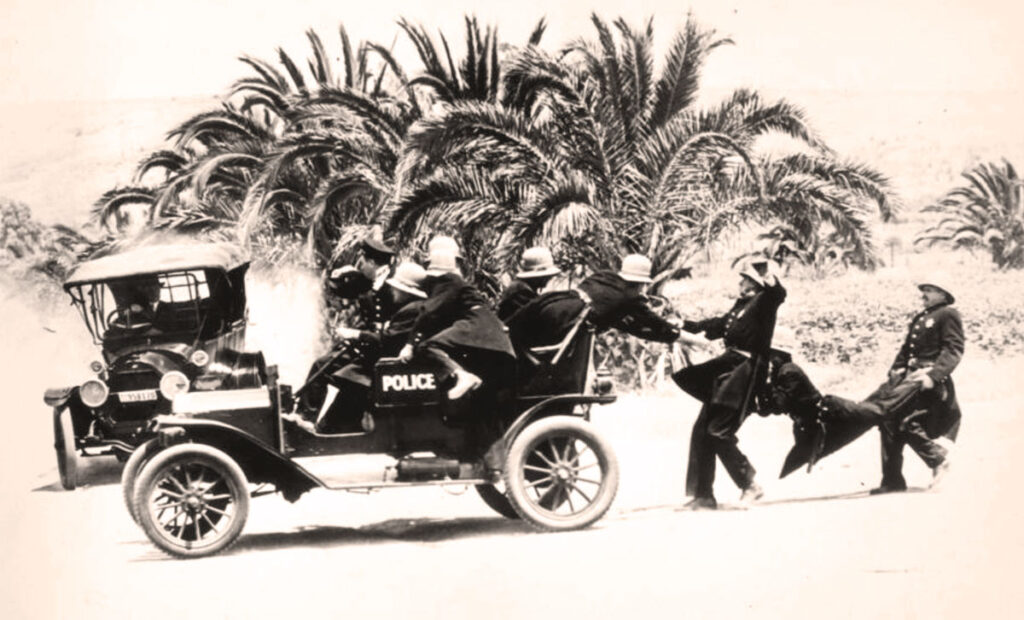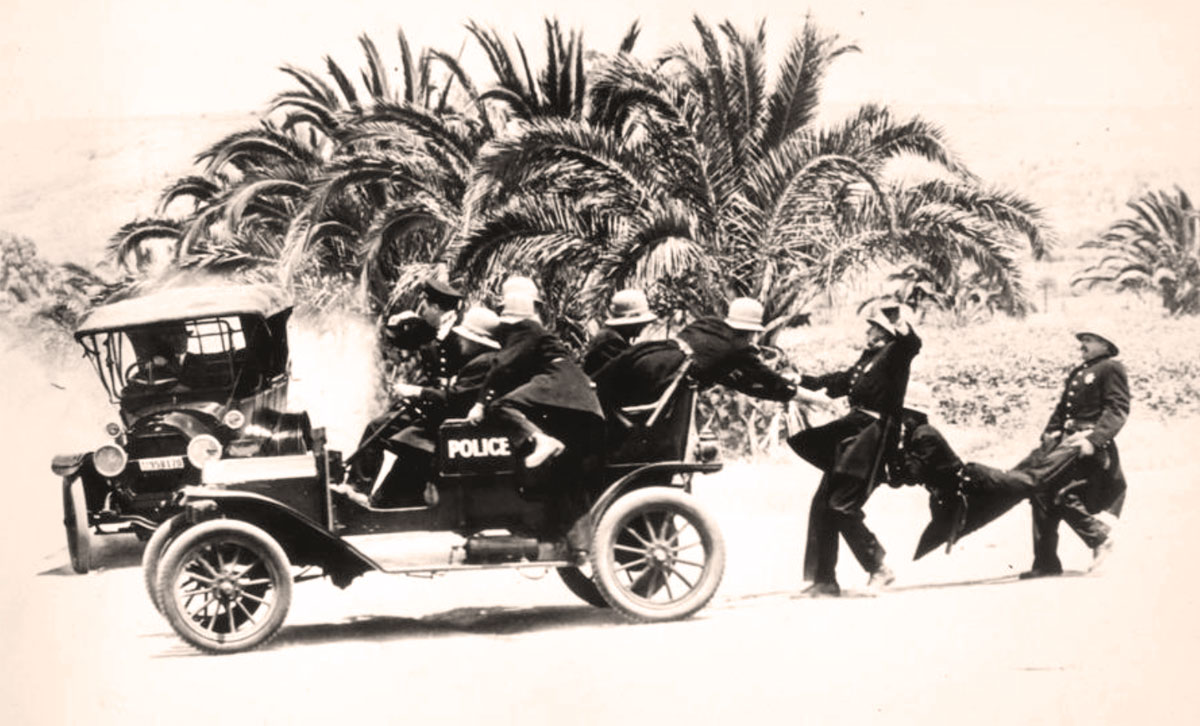Yes, sometimes silent films are run too fast, faster than they ought to be. Some of them, anyway. For a long time, there weren’t any options about this, and this either became something fans got accustomed to or became a stereotype about silent movies that could be off-putting.
The projection rate at which sound film is run was locked in 1925 or 1926, at 90 feet per minute, or 24 frames per second. Once talking pictures took over from silents, projectors no longer had rheostats on them for adjusting projection speed up or down as there’d been before 1929. This was the case both for theatrical 35mm projectors as well as for 16mm ones used in schools, homes, and telecine equipment used by television stations to broadcast motion picture film.
Silent film was seen — when it was seen — at this one frame rate starting in the 1930s. This generated the “herky-jerky” stereotype of silent film that people think of. Not all silent movies, but the films made in the 1910s and maybe early 1920s have this too-much-espresso look to them.
A lot of people, collectors and archives alike, think of 18 fps as “silent speed” and that it applies to all silent films. I have a theory about where this term came from, and I’ll cover that in another post.
Having had the opportunity to accompany silent films at MoMA (the Museum of Modern Art) in NYC for many years, I discovered that their projectors were variable-speed, and that film shown in their cinemas could be run at a variety of speeds. Not just the either/or of 24 fps or 18. I had a lot of chances to see which speeds worked best for films from different years, and also gradually got to have input on the running speed of a film I was going to accompany.
What I noticed over years of doing shows is that silent films from different parts of the silent era look and seem “fine” when run at 24 fps, and some do not. I realized two things — one that I couldn’t quite explain, and one that I could. The first is that it seemed that films from the early ‘teens held up best at a rate of 18 fps, from the mid-‘teens at a range from 18-21, in the early ‘20s at 20-22, and then from around 1923 on 24 fps seemed fine. The further back you went, the slower the projection speed needed to be (or vice versa).

By “looked fine” I mean that there is a certain amount of decoding we in the audience are required to do in viewing the films. What I noticed with films from the 1910s is that when they were run at a more hospitable speed I noticed that a lot of facial expression and reactions became visible and decodable. When over-speeding a film from the 1910s these reactions – information we’re being given, and need to take in – get erased, and the motivation or reason a character onscreen does something can get erased.
It zips by, leaving only the physical action the decision has precipitated. Leaving the impression of people “running around like the Keystone Kops”. For decades, the only way to see Keystone shorts from 1914-1916 were in editions shown on TV run at 24 fps. I’ve had many opportunities to watch Keystone shorts projected at 20 or 21 fps and have noticed that at that rate the slapstick still lands, but the character’s decision to throw those bricks (it’s always bricks, and rarely pies) is decodable. Not like in an O’Neill play, but just enough so the films don’t play like a Punch and Judy puppet show.
The realization that there was this gradual shift in silent films’ being less or more decodable from 1910-1929 if you watch all of them at one projection speed was what set me off on the next part of my exploration of filming and projection speeds in Silent Film.
The first post in this series is here.
The previous post (#41) to this one is here.

That is a very interesting observation, Ben! When you make your DVDs, do you adjust the speed to an optimal level?
Denise, yes I take a lot of care based on my research and my experiences over the decades in theaters playing for the films.
Excellent! Thank you for explaining in more detail about the speed variation. Interesting that the slightest adjustment in projection speed can register facial expressions without interfering with pratfall timing.
It’s a rather specific discover I’ve made in doing some of the deconstructions that I put on YouTube years ago when I began all this.
This is a natural progression of the film technology. Filming a scene at 12 to 14 fps will result in a lot of nuance and subtlety being lost even if the film is projected at that rate. Filming at 24 fps preserves those little touches. I *think* there is a section in Walter Kerr’s book “The Silent Clowns” which addresses this and notes that there are cue sheets for “The General” which suggest that it should be shown at a rate of about 26 fps! When I was a kid, we had a Super 8 silent Argus projector which had a variable speed rheostat on it, and that was very welcome indeed. I’m glad that video technology allows for variable speeds, but I’m not always happy with the results. There’s a DVD transfer out there of Keaton’s “The Boat” which is much too slow — often the case with transfers by David Shepard, bless him — and the Lobster Films “restorations” of the Chaplin Mutuals are entirely too slow for my tastes, some of them running 27 minutes and change for a two-reeler. Surely Douglas Fairbanks understood what he would lose once his films had to be filmed and projected at 24fps; he depended upon that extra 2 or 3 fps speed increase for the effect of having boundless energy and being lighter than air.
There’s a section in the Kevin Brownlow “Hollywood” documentary which addresses filming speed; I’m pretty sure it’s in “Trick of the Light,” about cinematography. At one point, Allan Dwan is talking about the speed of hand-cranking a silent camera, and he says that “normal” speed was achieved by saying “A-hundred-and-one” for each complete turn of the crank.
I hope this doesn’t give away the answer (and it probably isn’t the answer), but one other way of judging “proper speed,” beyond how fast the characters are moving, is how long each shot is held. If the characters appear to be moving normally but each shot drags on for an eternity, it is likely being projected too slowly. I’ve seen many silent films that were shot at 16 and edited for 24 (or something in that neighborhood). I think that is why silent dramas, which wouldn’t logically undercrank for comic effect, still look better projected slightly “too fast” if the individual shots are held long enough for the audience to interpret them, as you say, but not so long that the audience interprets them and still has time to get popcorn before the next cut.
You’re getting ahead of me just a bit, but your rule-of-thumb can be useful — if you don’t know the year of release, which tells you something about what speed a particular film would have been shown at and expected to be shown at by its makers.
I love the way the characters ponder before they throw bricks in O’Neill plays. A lot of modern productions leave the brick-throwing out, and you’re really missing something important when they do that.
Especially the coconut sound effects!
I’ve always wondered if early “undercranking” was possibly just the simple result of human frailty, or the natural physical limitations of the human arm. I mean, how fast and long can one crank before the arm gets tired, or naturally and unconsciously slows down a few fps.
BTW: Could a lefty crank comfortably and consistently with the right hand?? Or, were there lefty and righty capable crank cameras??
BTW2: Near the beginning of the dreadful “Chaplin” bio-pic by David Attenborough, Charlie sees his first silent film, with the projectionist hand-cranking the projector. Were there hand cranked projectors in the early days of silent film?? If so, that would certainly result in films running at a wide variety of different speeds. And if so, how long could a projectionist crank before his arm got too tired to crank? (May I suggest team cranking?) And they’d be forced to crank at a pretty good fps, or the heat of the bulb might send the nitrate film into flames!!
Projectors were hand-cranked from the beginning, and motors came in during the mid-‘teens. The Moving Picture World issues I’ve been reading from 1916 nearly alway mention motorized projectors in their stories covering movie theater every week.
The cranks on cameras were always on the right side, from what I’ve seen.
I don’t think undercranking was from ‘human frailty’, as you had to keep the movement steady throughout. R. Totheroh mentions in his interview that part of how he got one of his pre-Mutuals jobs was that he knew his speeds. I have a feeling that undercranking – the deliberate usage of it – must have come from trial and error and seeing what different speeds looked like when projected.
The Bell & Howell cameras had ball-bearings which made for easier and smoother cranking.
Thanks, that’s really interesting (but my right arm is getting sore just thinking about cranking a projector non-stop, even for a one-reeler).
I would’ve loved to have been a camera operator during the early silent era. What an art!!
If I were the cameraman on “The Floorwalker,” I might have pointed out, “Hey Charlie, the wind is causing the dresses on the mannequins to wave like laundry on a clothesline. This is supposed to be inside a department store, right Chuck?” Undercranking in this case makes those dresses look like they’re in a hurricane.